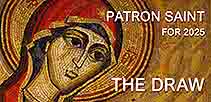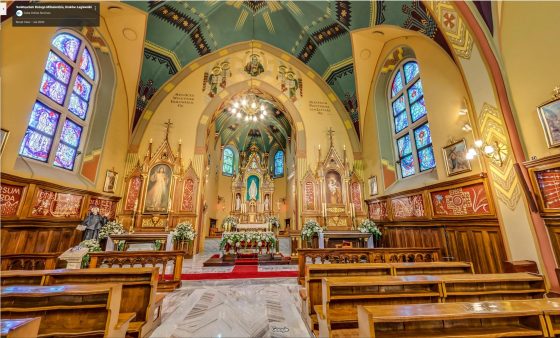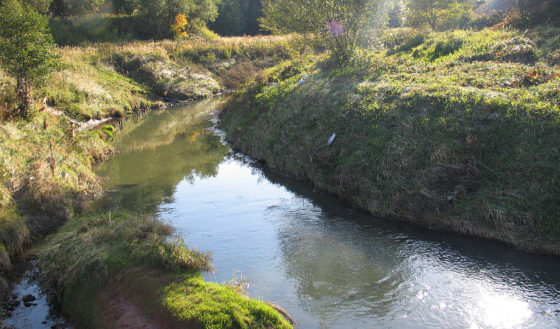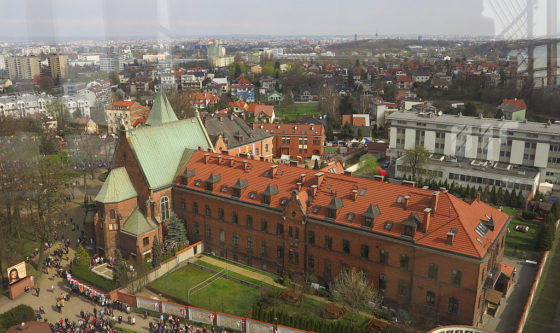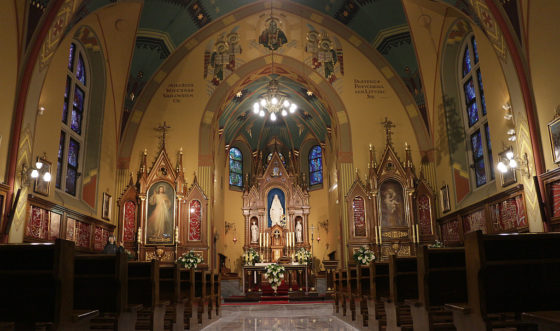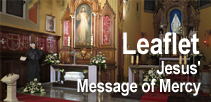We are now at the very heart of the Łagiewniki Shrine, the Chapel which contains the Holy Picture of the Merciful Jesus, renowned for the miracles it has wrought, and the Tomb of St. Faustina. This fairly small house of worship was dedicated to St. Joseph and consecrated in 1891. Erected on the premises of the Convent of the Sisters of Our Lady of Mercy, originally it was used only by the Sisters and their wards. Sister Faustina, the Apostle of Divine Mercy, used to pray here. Here she received extraordinary graces; here Jesus and His Blessed Mother appeared to her. When she died, the message of Divine mercy which Jesus wanted her to disseminate in the Church and the world was lodged in this place, and so the Łagiewniki Shrine became the hub of devotion to the Divine Mercy, the place from which this message is spread throughout the world and the destination for pilgrims from every part of the world. They come to ask for many graces, and the walls of the chapel are decorated with votive offerings pilgrims donate in thanksgiving for the graces they have received here.
The Holy Picture of the Merciful Jesus by Adolf Hyła is over the left-hand side altar. It was consecrated on 16 April 1944, the first Sunday after Easter, by Father Józef Andrasz SJ, Sister Faustina’s Cracovian spiritual director. Thousands of copies and reproductions of this image have spread throughout the world, thereby fulfilling the request Jesus made when He first appeared to Sister Faustina, “I want this picture venerated first in your chapel, and in the whole world” (Diary 47).
The Tomb of Sister Faustina is below the mensa of the altar of the Merciful Jesus. The little coffin made of white marble holds her mortal remains, and there is a relic in a marble reliquary in front of the altar, for pilgrims wishing to venerate and ask for her prayers and powerful intercession with the Divine Mercy.
There is a statue of Our Lady of Mercy, the Congregation’s Patroness, over the main altar, flanked by statues of St. Stanislaus Kostka, Patron Saint of young people, and St. Mary Magdalene, Patroness of repentant women. A picture of St. Joseph with the Infant Jesus hangs over the right-hand side altar. St. Joseph was this Community’s first Patron; its Chapel and entire property, originally called “Józefów” in his honour, were dedicated to him. On the side walls there are pictures of St. Sister Faustina (by Helena Tchórzowska), St. Ignatius Loyola, another of the Congregation’s patron, and Bl. Father Michał Sopoćko, Sister Faustina’s spiritual director in Vilnius.
By 1968, so many pilgrims were coming here to pray before the Holy Picture of the Merciful Jesus and at Sister Faustina’s graveside that Cardinal Karol Wojtyła entered the Chapel on the list of sanctuaries in the Archdiocese of Kraków, and in 1992, “in consideration of the rapidly expanding devotion to the Divine Mercy,” Cardinal Franciszek Macharski issued a decree appointing the Chapel the official Sanctuary of the Divine Mercy.
1. The history of Łagiewniki
The Łagiewniki Shrine of Divine Mercy is located in the southern part of the City of Kraków. The name Łagiewniki comes from an Old Polish word for a place whose inhabitants made łagwie, wooden, leather, metal or ceramic vessels for water or beverages. The first written record of this village comes from the fourteenth century, although traces of settlement here date back to Roman times, and even to the New Stone Age, as archaeological excavations have shown. The local people were farmers, craftsmen and traders, and the ancient via regalis, the royal north-to-south trade route ran through the village. Initially, Łagiewniki was a settlement providing services for Kraków Castle and the royal court. In the thirteenth and fourteenth century it was an agricultural estate and a centre for local trade. In the fifteenth century the Castellan of Kraków became its proprietor; when Poland lost its independence and was partitioned in the late eighteenth century Łagiewniki was held by various owners. The centre of the village accommodated a dwór (the traditional Polish country residence of the local landlord) with its ancillary buildings and outhouses.
A paper mill, Łagiewniki’s first manufactory, started operations in the seventeenth century. But its real growth as an industrial centre, which completely changed its character, came in the nineteenth and early twentieth century, when a deposit of clay, shale and gypsum, raw materials for the construction industry, was discovered in the area. Łagiewniki became a centre for quarries and opencast mining, with a stone grinding mill, brickyards, tile-works, and eventually a steel mill and a factory producing machines and metal fittings. Other factories, such as a chandlery, a furniture factory, and, and cottage industries emerged alongside its flourishing construction industry. In 1901, the Solvay soda and ammonia works were established in the neighbouring village of Borek Fałęcki and rapidly increased production, employing more and more local people and becoming one of the largest industrial companies in Kraków. The Solvay factory neighboured on the Łagiewniki Convent, and during the Second World War Karol Wojtyła was one of its employees.
With Łagiewniki’s industrial boom, its population grew and its architectural landscape changed. Its wooden cottages vanished, ousted by suburban brick buildings, detached houses and gardens, sophisticated country residences and tenement buildings. The old village was transformed into a suburban industrial centre, with the largest factories in the region employing hundreds of workers.
When Poland was invaded and occupied by Germany during the Second World War, Hans Frank, the German Governor-General, had Łagiewniki incorporated in the City of Kraków. Even before the War, during the Great Depression at the turn of the 1930s, many of the small brickyards went into decline and were shut down. When the Communists came to power after the War, they nationalised the large factories; some were converted into new businesses and others like Solvay were closed. New housing estates, roads and two parishes were created in Łagiewniki. Currently Łagiewniki and Borek Fałęcki are in Kraków’s District Nine.
2. Łagiewniki Convent
In the late nineteenth century, Cardinal Albin Dunajewski, Archbishop of Kraków, designated a large fund for the foundation of a convent with educational facilities for girls and women in need of profound moral renewal. The money came from an endowment provided by Prince Aleksander Lubomirski, a financier and philanthropist, and was sufficient to buy several hectares of land from Samuel and Bernard Wohlfeld and local farmers. Set on a hill in the village of Łagiewniki, the property was enclosed by a wall and called “Józefów” in honour of St. Joseph, because the Community had St. Joseph to thank for the Łagiewniki foundation and considered him the master of the house. The construction work was directed by the architect Karol Zaremba and builder Ignacy Miarczyński. On 20 August 1891, Cardinal Dunajewski consecrated the Chapel, dedicating it to St. Joseph, and also the wing of the convent buildings designated for the Congregation’s apostolic work.
The Congregation’s educational work with “fallen women” (as their charges were called at the time) meant that the Convent’s entire premises were out of bounds to outsiders. The main incentives the Sisters relied on in their educational work were grounded in the faith, respect for human dignity and the individual’s freedom. Work was another important educational instrument: not only did it provide the girls with an income but it also fostered the Christian virtues, helped in the development of their characters, and prepared them for honest work in the outside world. The Sisters’ House of Mercy (as the Congregation’s apostolic institutions were called) offered their charges several facilities: a bookbinder’s shop, a laundry, a needlework and weaver’s workshop, in which they could get a professional training for a future career. Or they could choose horticulture and farming, and learn the basics for a job in agriculture. Every day in the life of the Sisters and their charges was full of work and prayer.
During the First World War, part of the property was sequestered for use as a military hospital for soldiers of different nationalities with infectious diseases such as typhus, cholera, dysentery, smallpox, or scarlet fever. In 1914-1915, a total of 2,400 soldiers were treated in the hospital. Those who died were buried in a graveyard outside the convent wall.
During the Second World War, the German occupying authorities made the Łagiewniki Convent a German property, and the Congregation had to supply the invaders with a mandatory quota of agricultural produce. The Sisters continued to run the House of Mercy, but now the German authorities used it as a detention centre for women caught smuggling or trading on the black market, which flourished in wartime conditions because the official food rations the Germans imposed were below subsistence level. The Sisters provided aid for evicted and displaced persons and took an active part in the secret educational scheme Polish teachers organised clandestinely because the Germans closed down all the schools for Polish children and young people (except for the basic three years of education, just enough to teach the Three Rs). The Sisters also did charity work and ran a soup kitchen for the poor.
In 1962, the Communist authorities took over the Congregation’s educational institution and confiscated most of the property. In 1969 the Sisters launched a day centre called Źródło (Source), which provided care for youngsters with socially maladaptive behaviour, and which operated until 1991. When the Communist system of government fell in 1989, the authorities returned the Community’s educational institution. Today it is a young people’s educational centre operating as a boarding school and rehabilitation facility for socially maladjusted girls, offering a secondary education programme for the 12-19 age range and a post-secondary training course for hairdressing and the catering industry.
This Convent was where Sister Faustina Kowalska lived and died, and where Jesus entrusted His message of mercy to her. He asked her to remind the world of the biblical truth of God’s merciful love for every human being, and to call them to proclaim this truth by giving witness to it in their lives in their words, deeds, and prayers. Today the Congregation of Sisters of Our Lady of Mercy, which recognises St. Faustina as its spiritual Co-Foundress, is proclaiming the message of mercy, not only through prayer and the witness of their lives and work of mercy for girls in need of moral renewal, but also by word, providing a service for pilgrims and running formation courses for Apostles of Divine mercy in the Faustinum Association; in the work of the Misericordia Publishing House, the quarterly magazine Orędzie Miłosierdzia and in the mass media.
3. The Chapel of the Merciful Jesus and the Tomb of St. Faustina
The Chapel of St. Joseph, which connects the two wings of the convent buildings, was consecrated by Cardinal Albin Dunajewski on 20 August 1891. Its main altar was designed by Ferdynand Majerski of Przemyśl, with a statue of Our Lady of Mercy, the Congregation’s Patroness, as its centrepiece, flanked by St. Stanislaus Kostka, Patron of young religious on the left, and St. Mary Magdalene, Patroness of penitent women, on the right. The Holy Picture of the Merciful Jesus is over the left side-altar. It was installed on top of a late nineteenth-century painting of the Sacred Heart by Jan Bąkowski. A Holy Picture of St. Joseph with the Infant Jesus (by Franciszek Krudowski) is over the side-altar on the right.
During the Second World War, the Łagiewniki Convent, previously out of bounds to outsiders, opened to take in refugees and people who wanted to pay their respects at the graveside of Sister Faustina, as the fame of her saintly life and the ever increasing devotion to the Divine Mercy was spreading far and wide. On 7 March 1943, Father Józef Andrasz SJ, Sister Faustina’s Cracovian confessor, consecrated the first painting of the Merciful Jesus made by Adolf Hyła, and started regular services of prayers and devotion to the Divine Mercy, which attracted crowds of worshippers from the City of Kraków and its environs. Hyła made a second painting of the Merciful Jesus to fit the recess over the side-altar, and Father Andrasz blessed it on 16 April 1944 the Feast of Mercy (the first Sunday after Easter). This Holy Picture soon became famous for the miracles it wrought and the graces bestowed here. Copies and reproductions spread throughout the world, fulfilling the request Jesus asked of Sister Faustina, to have the image of His Mercy venerated first in the Congregation’s Chapel at Łagiewniki, and throughout the world.
The paintings decorating the Chapel’s walls were designed by Zdzisław Gedliczka in 1934, and renovated during a general restoration of the Chapel in 1981-1990. A series of stained glass windows by Wiktor Ostrzołek, was mounted in the Chapel’s side windows and porch. The only one predating this restoration project is St. Cecilia, in the ocular (round window) at the back of the musicians’ choir. On the walls around the chapel there are display cabinets containing an arrangement of votive offerings donated by pilgrims in thanksgiving for the graces they have received here.
In 1968 Cardinal Karol Wojtyła entered the Chapel on the list of sanctuaries in the Archdiocese of Kraków, and in 1992, “in consideration of the rapidly expanding devotion to the Divine Mercy,” Cardinal Franciszek Macharski issued a decree appointing the Chapel the official Sanctuary of the Divine Mercy. In front of the Chapel there is a bas-relief of Pope John Paul II (designed by Prof. Czesław Dźwigaj), commemorating the Pope’s first papal pilgrimage to Łagiewniki (7 June 1997), and on the other side there is a plaque by Andrzej Zaradkiewicz commemorating the pilgrimage of Pope Benedict XVI on 27 May 2006. On the convent building next to the entrance to the Chapel there is a plaque designed by Czesław Dźwigaj, which points to the cell in the erstwhile infirmary where St. Sister Faustina died.
Sr. M. Elżbieta Siepak ISMM
This text uses excerpts from Sister Siepak’s article “Jan Paweł II pielgrzym łagiewnicki i sługa orędzia Miłosierdzia” (on John Paul II, a Łagiewniki pilgrim and Servant of the Message of Mercy), first published in Przyroda, geografia, turystyka w nauczaniu Jana Pawła II (ed. Fr. Maciej Ostrowski and Izabela Sołjan, Kraków: Papieska Akademia Teologiczna, 2007, 113-126).
Translated by Orest Pawlak










